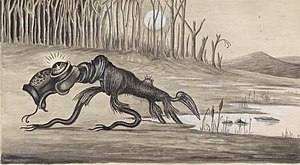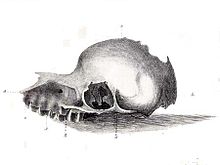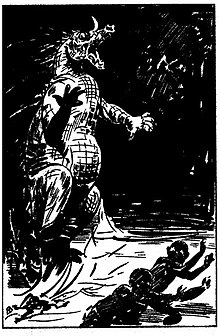
Bunyip


The bunyip is a creature from the aboriginal mythology of southeastern Australia, said to lurk in swamps, billabongs, creeks, riverbeds, and waterholes.

Name
The origin of the word bunyip has been traced to the Wemba-Wemba or Wergaia language of the Aboriginal people of Victoria, in South-Eastern Australia.[1][2][3][4]

The word bunyip is usually translated by Aboriginal Australians today as "devil" or "evil spirit".[5] This contemporary translation may not accurately represent the role of the bunyip in pre-contact Aboriginal mythology or its possible origins before written accounts were made. Some modern sources allude to a linguistic connection between the bunyip and Bunjil, "a mythic 'Great Man' who made the mountains, rivers, man, and all the animals".[6]

The word bahnyip first appeared in the Sydney Gazette in 1812.[7] It was used by James Ives to describe "a large black animal like a seal, with a terrible voice which creates terror among the blacks".[8]

Distribution
The bunyip is part of traditional Aboriginal beliefs and stories throughout Australia, while its name varies according to tribal nomenclature.[9] In his 2001 book, writer Robert Holden identified at least nine regional variations of the creature known as the bunyip across Aboriginal Australia.[10]

Characteristics

The bunyip has been described as amphibious, almost entirely aquatic (there are no reports of the creature being sighted on land),[11][a] inhabiting lakes, rivers,[12] swamps, lagoons, billabongs,[6] creeks, waterholes,[13] sometimes "particular waterholes in the riverbeds".[14]

Physical descriptions of bunyips vary widely. George French Angus may have collected a description of a bunyip in his account of a "water spirit" from the Moorundi people of the Murray River before 1847, stating it is "much dreaded by them ... It inhabits the Murray; but ... they have some difficulty describing it. Its most usual form ... is said to be that of an enormous starfish."[15] The Challicum bunyip, an outline image of a bunyip carved by Aboriginal people into the bank of Fiery Creek, near Ararat, Victoria, was first recorded by The Australasian newspaper in 1851. According to the report, the bunyip had been speared after killing an Aboriginal man. Antiquarian Reynell Johns claimed that until the mid-1850s, Aboriginal people made a "habit of visiting the place annually and retracing the outlines of the figure [of the bunyip] which is about 11 paces long and 4 paces in extreme breadth".[16] The outline image no longer exists.[17] Robert Brough Smyth's Aborigines of Victoria (1878) devoted ten pages to the bunyip, but concluded "in truth little is known among the blacks respecting its form, covering or habits; they appear to have been in such dread of it as to have been unable to take note of its characteristics".[18] Eugénie Louise McNeil recalled from her childhood memory in the 1890s that the bunyip supposedly had a snout like an owl ("a mopoke"), and was probably a nocturnal creature by her estimation.[13]

The bunyips presumably seen by witnesses, according to their descriptions, most commonly fit one of two categories: 60% of sightings resemble seals or swimming dogs, and 20% of sightings are of long-necked creatures with small heads; the remaining descriptions are ambiguous beyond categorisation. The seal-dog variety is most often described as being between 4 and 6 feet long with a shaggy black or brown coat. According to reports, these bunyips have round heads resembling a bulldog, prominent ears, no tail, and whiskers like a seal or otter. The long-necked variety is allegedly between 5 and 15 feet long, and is said to have black or brown fur, large ears, small tusks, a head like a horse or emu, an elongated, maned neck about three feet long and with many folds of skin, and a horse-like tail. The bunyip has been described by natives as amphibious, nocturnal, reclusive, and inhabiting lakes, rivers, and swamps. Bunyips, according to Aboriginal mythology, can swim swiftly with fins or flippers, have a loud, roaring call, and feed on crayfish, though some legends portray them as bloodthirsty predators of humans, particularly women and children. As a result, Aboriginal People purposely avoided unfamiliar bodies of water lest there were bunyips lurking in the depths. Bunyip eggs are allegedly laid in platypus nests.[20]

The bunyip appears in Ngarrindjeri dreaming as a water spirit called the Mulyawonk, which would get anyone who took more than their fair share of fish from the waterways, or take children if they got too close to the water. The stories taught practical means of ensuring long-term survival for the Ngarrindjeri, embodying care for country and its people.[21]

Debate over origins
There have been various attempts to understand and explain the origins of the bunyip as a physical entity over the past 150 years. Writing in 1933, Charles Fenner suggested that it was likely that the "actual origin of the bunyip myth lies in the fact that from time to time seals have made their way up the Murray and Darling (Rivers)". He provided examples of seals found as far inland as Overland Corner, Loxton, and Conargo and reminded readers that "the smooth fur, prominent 'apricot' eyes, and the bellowing cry are characteristic of the seal",[22] especially southern elephant seals and leopard seals.[23]

Another suggestion is that the bunyip may be a cultural memory of extinct Australian marsupials such as the Diprotodon, Zygomaturus, Nototherium, or Palorchestes. This connection was first formally made by Dr George Bennett of the Australian Museum in 1871.[24] In the early 1990s, palaeontologist Pat Vickers-Rich and geologist Neil Archbold also cautiously suggested that Aboriginal legends "perhaps had stemmed from an acquaintance with prehistoric bones or even living prehistoric animals themselves ... When confronted with the remains of some of the now extinct Australian marsupials, Aborigines would often identify them as the bunyip." They also note that "legends about the mihirung paringmal of western Victorian Aborigines ... may allude to the ... extinct giant birds the Dromornithidae."[25]

In a 2017 Australian Birdlife article, Karl Brandt suggested Aboriginal encounters with the southern cassowary inspired the myth.[26] According to the first written description of the bunyip from 1845,[27] the creature laid pale blue eggs of immense size, possessed deadly claws, powerful hind legs, a brightly coloured chest, and an emu-like head, characteristics shared with the Australian cassowary.[26] As the creature's bill was described as having serrated projections, each "like the bone of the stingray", this bunyip was associated with the indigenous people of Far North Queensland, renowned for their spears tipped with stingray barbs and their proximity to the cassowary's Australian range.

Another association to the bunyip is the shy Australasian bittern (Botaurus poiciloptilus).[28] During the breeding season, the male call of this marsh-dwelling bird is a "low pitched boom";[29] hence, it is occasionally called the "bunyip bird".[6]

Early accounts of European settlers

During the early settlement of Australia by Europeans, the notion became commonly held that the bunyip was an unknown animal that awaited discovery. Unfamiliar with the sights and sounds of the island continent's peculiar fauna, early Europeans believed that the bunyip described to them was one more strange Australian animal and they sometimes attributed unfamiliar animal calls or cries to it. Scholars suggest also that 19th-century bunyip lore was reinforced by imported European folklore, such as that of the Irish Púca.[6]

A large number of bunyip sightings occurred during the 1840s and 1850s, particularly in the southeastern colonies of Victoria, New South Wales and South Australia, as European settlers extended their reach. The following is not an exhaustive list of accounts:

First written use of the word bunyip, 1845
In July 1845, The Geelong Advertiser announced the discovery of fossils found near Geelong, under the headline "Wonderful Discovery of a new Animal".[27] This was a continuation of a story on 'fossil remains' from the previous issue.[30] The newspaper continued, "On the bone being shown to an intelligent black, he at once recognised it as belonging to the bunyip, which he declared he had seen.[27] On being requested to make a drawing of it, he did so without hesitation." The account noted a story of an Aboriginal woman being killed by a bunyip and the "most direct evidence of all" – that of a man named Mumbowran "who showed several deep wounds on his breast made by the claws of the animal".[27]

The account provided this description of the creature:

The Bunyip, then, is represented as uniting the characteristics of a bird and of an alligator. It has a head resembling an emu, with a long bill, at the extremity of which is a transverse projection on each side, with serrated edges like the bone of the stingray. Its body and legs partake of the nature of the alligator. The hind legs are remarkably thick and strong, and the fore legs are much longer, but still of great strength. The extremities are furnished with long claws, but the blacks say its usual method of killing its prey is by hugging it to death. When in the water it swims like a frog, and when on shore it walks on its hind legs with its head erect, in which position it measures twelve or thirteen feet in height.[31]
Shortly after this account appeared, it was repeated in other Australian newspapers.[32] This appears to be the first use of the word bunyip in a written publication.

Australian Museum's bunyip of 1847

In January 1846, a peculiar skull was taken by a settler from the banks of Murrumbidgee River near Balranald, New South Wales. Initial reports suggested that it was the skull of something unknown to science.[33] The squatter who found it remarked, "all the natives to whom it was shown called [it] a bunyip".[34] By July 1847, several experts, including W. S. Macleay and Professor Owen, had identified the skull as the deformed foetal skull of a foal or calf.[35] At the same time, the purported bunyip skull was put on display in the Australian Museum (Sydney) for two days. Visitors flocked to see it, and The Sydney Morning Herald reported that many people spoke out about their "bunyip sightings".[36] Reports of this discovery used the phrase 'Kine Pratie' as well as Bunyip.[37] Explorer William Hovell, who examined the skull, also called it a 'katen-pai'.[38]

In March of that year, "a bunyip or an immense Platibus" (Platypus) was sighted "sunning himself on the placid bosom of the Yarra, just opposite the Custom House" in Melbourne. "Immediately a crowd gathered" and three men set off by boat "to secure the stranger" which "disappeared" when they were "about a yard from him".[39]

William Buckley's account of bunyips, 1852
Another early written account is attributed to escaped convict William Buckley in his 1852 biography of thirty years living with the Wathaurong people. His 1852 account records "in ... Lake Moodewarri [now Lake Modewarre] as well as in most of the others inland ... is a ... very extraordinary amphibious animal, which the natives call Bunyip." Buckley's account suggests he saw such a creature on several occasions. He adds, "I could never see any part, except the back, which appeared to be covered with feathers of a dusky grey colour. It seemed to be about the size of a full grown calf ... I could never learn from any of the natives that they had seen either the head or tail."[40] Buckley also claimed the creature was common in the Barwon River and cites an example he heard of an Aboriginal woman being killed by one. He emphasized the bunyip was believed to have supernatural powers.[41]

Stocqueler's sightings and drawings, 1857
In an article titled, 'The Bunyip', a newspaper reported on the drawings made by Edwin Stocqueler as he travelled on the Murray and Goulburn rivers: 'Amongst the latter drawings we noticed a likeness of the Bunyip, or rather a view of the neck and shoulders of the animal. Mr. Stocqueler informs us that the Bunyip is a large freshwater seal, having two small padules or fins attached to the shoulders, a long swan like neck, a head like a dog, and a curious bag hanging under the jaw, resembling the pouch of the pelican. The animal is covered with hair, like the platypus, and the colour is a glossy black. Mr. Stocqueler saw no less than six of these curious animals at different times; his boat was within thirty feet of one near M'Guire's punt on the Goulburn, and he fired at the Bunyip, but did not succeed in capturing him. The smallest appeared to be about five feet in length, and the largest exceeded fifteen feet. The head of the largest was the size of a bullock's head, and three feet out of water. After taking a sketch of the animal, Mr. Stocqueler showed it to several blacks of the Goulburn tribe, who declared that the picture was "Bunyip's brother," meaning a duplicate or likeness of the bunyip. The animals moved against the current, at the rate of about seven miles an hour, and Mr. Stockqueler states that he could have approached close to the specimens he observed, had he not been deterred by the stories of the natives concerning the power and fury of the bunyip, and by the fact that his gun had only a single barrel, and his boat was of a very frail description.'[42]

The description varied across newspaper accounts: 'The great Bunyip question seems likely to be brought to a close, as a Mr. Stocqueler, an artist and gentleman, who has come up the Murray in a small boat, states that he saw one, and was enabled to take a drawing of this "vexed question," but could not succeed in catching him. We have seen the sketch, and it puts us in mind of an hybrid between the water mole and the great sea serpent.'[43] 'Mr. Stocqueler, an artist, and his mother are on an expedition down the Murray, for the purpose of making some faithful sketches of the views on this fine stream, as well as of the creatures frequenting it. I have seen some of their productions, and as they pourtray localities with which I am well acquainted, can pronounce the drawings faithful representations. Mother and son go down the stream in a canoe. The lady paints flowers, &c.; the son devotes himself to choice views on the river's side. One of the drawings represents a singular creature, which the artist is unable to classify. It has the appearance in miniature of the famous sea-serpent, as that animal is described by navigators. Mr. Stocqueler was about twenty-five yards distant from it at first sight as it lay placidly on the water. On being observed, the stranger set-off, working his paddles briskly, and rapidly disappeared. Captain Cadell has tried to solve the mystery, but is not yet satisfied as to what the animal really is. Mr. Stocqueler states that there were about two feet of it above water when he first saw it, and he estimated its length at from five to six feet. The worthy Captain says, that unless the creature is the "Musk Drake" (so called from giving off a very strong odour of musk), he cannot account for the novelty.'[44]

Stocqueler disputed the newspaper descriptions in a letter; stating that he never called the animal a bunyip, it did not have a swan like neck, and he never said anything about the size of the animal as he never saw the whole body.[45] He went on to write that all would be revealed in his diorama as an 'almost life size portrait of the beast' would be included. The diorama took him four years to paint and was reputed to be a mile (1.6 km) long and made of 70 individual pictures. The diorama has long since disappeared and may no longer exist.[46]

Figure of speech and eponymy
By the 1850s, bunyip was also used as a "synonym for impostor, pretender, humbug and the like",[2] although this use of the word is now obsolete in Australian English.[47] The term bunyip aristocracy was first coined in 1853 to describe Australians aspiring to be aristocrats.[2][19] In the early 1990s, Prime Minister Paul Keating used this term to describe members of the conservative Liberal Party of Australia opposition.[48][49]

The word bunyip can still be found in a number of Australian contexts, including place names such as the Bunyip River (which flows into Westernport Bay in southern Victoria) and the town of Bunyip, Victoria.

In popular culture and fiction
- The Bunyip is a local weekly newspaper published in the town of Gawler, South Australia. First published as a pamphlet by the Gawler Humbug Society in 1863, the name was chosen because "the Bunyip is the true type of Australian Humbug!"[50]
- A private residence built in the 1860s in Clifton Hill, Victoria, was redeveloped in the 1970s as the "House of the Gentle Bunyip", an ecumenical Christian community, the first of several such initiatives.[51]

Numerous tales of the bunyip in written literature appeared in the 19th and early 20th centuries. One of the earliest known is a story in Andrew Lang's The Brown Fairy Book (1904), adapted from a tale collected and published in the Journal of the Anthropological Institute in 1899.[52]


- Well-known Australian author Colin Thiele wrote Gloop The Gloomy Bunyip, an illustrated children's book published in 1962.
- The character Alexander Bunyip, created by children's author and illustrator Michael Salmon, first appeared in print in The Monster That Ate Canberra (1972).[53] Salmon featured the Bunyip character in many other books and adapted his work as a live-action television series, Alexander Bunyip's Billabong.[54] A statue of Alexander Bunyip by Anne Ross, called A is for Alexander, B is for Bunyip, C is for Canberra, was commissioned by the ACT Government for Gungahlin's $3.8 million town park[55] and installed in front of the Gungahlin Library in 2011.[56]
- (1916) ragtime musical comedy The Bunyip or The Enchantment of Fairy Princess Wattle Blossom by Ella Palzier Campbell (AKA Ella Airlie) toured nine venues in three states for a year with Fuller Brothers theatre circuit. Music was supplied by a number of Australian stage personalities including Vince Courtney, Herbert De Pinna, Fred Monument and James Kendis.[57]
The Australian tourism boom of the 1970s brought a renewed interest in bunyip mythology.

- (1972) A coin-operated bunyip was built by Dennis Newell at Murray Bridge, South Australia, at Sturt Reserve on the town's riverfront.[58]
- Jenny Wagner published a children's picture book, The Bunyip of Berkeley's Creek (1973).[59]
- (1977) The film Dot and the Kangaroo contains a song "The Bunyip (Bunyip Moon)".[60] The bunyip was the subject of Dot and the Smugglers where the title character, Dot, and her animal friends foil a circus-ringmaster's plan to capture a bunyip. The bunyip turns out to be a gentle, shy creature.
- (1982) Graham Jenkin wrote a children's picture book, The Ballad of the Blue Lake Bunyip[61]
- (1996) Australian children's author Jackie French wrote several bunyip tales, including the short story "Bunyip's Gift", collected in the anthology Mind's Eye.
- An episode of The Silver Brumby featured a friendly, prank-playing bunyip.
- Wommy, a character on Noah's Island, keeps mentioning bunyips and mistook Noah, the noble polar bear who's the title character, and feral cats for bunyips.
- (1986) The Australian film Frog Dreaming centres around the search for a bunyip called Donkegin.
- (2016) The independent Australian film Red Billabong was released in 2016. It tells of two estranged brothers who find themselves stalked by the Bunyip.[62]
Bunyip stories have also been published outside Australia.


- (1937) Bibhutibhushan Bandyopadhyay wrote a Bengali novel Chander Pahar (Mountain of the Moon) that included an account of a bunyip. The novel was adapted as a film of the same name, released in late 2013. The bunyip was portrayed as the primary threat to the treasure seekers in the wilderness of the Richtersveld mountains in southern Africa. In the novel, the bunyip is described as a three-toed ape-like hominid.
- From 1954 to 1966, Bertie the Bunyip was the lead puppet character on a popular children's series on Channel 3 in Philadelphia, Pennsylvania.[63]
- (1992) The roleplaying game, Werewolf: The Apocalypse, appropriates the Bunyip legend, having the Bunyip actually be a tribe of Australian native Garou, or werewolves. However, they are not playable in the game as, according to the game's lore, they were driven to extinction by the European werewolves during the colonisation of Australia.
The Bunyip has been featured in films as well.

- In the 1978 Ozploitation eco-horror film Long Weekend, a bunyip is featured as a creature that terrorizes the main couple in the film, who trash a peaceful Australian beach.
In the 21st century, the bunyip has been featured in works around the world.

- (2002) The video game series Ty the Tasmanian Tiger portrays Bunyips as peaceful, mystical elders who inhabit the world of The Dreaming, though not as ferocious as their namesake and resembling primates. The robotic suits that Ty can pilot in Ty the Tasmanian Tiger 2: Bush Rescue and Ty the Tasmanian Tiger 3: Night of the Quinkan are named after the Bunyips, such as Shadow Gunyip, Battle Gunyip and Missile Gunyips.
- (2008) The MMORPG Runescape features a familiar Bunyip, whom largely represents the folkore description.
- (2009) A character named Bruce Bunyip appears in the children's book The Neddiad by American Daniel Pinkwater. He is initially described as "big and swarthy, and had tiny eyes, a scowl and his eyebrows grew together" and later says he is a monster.[64]
- (2009) Bunyips appeared as the focus cryptids in an episode of The Secret Saturdays; however, they were depicted as small, troublemaking creatures instead of monsters.
- (2010) Bunyips appear in Naomi Novik's fantasy novel Tongues of Serpents, where they are depicted as relatives of dragons that have adapted to the extreme conditions of the Outback.[65]
- (2011) An episode of Prank Patrol (Australia) Season 2 involved a prank called Bunyip Hunters.
- (2014) In the novel Afterworlds, one of the characters is the author of a fictional book named Bunyip.
- (2014) The fantasy novel, Queen of the Dark Things, by C. Robert Cargill, features the Bunyip throughout the story.
- (2016) A "tri-horned" bunyip appears in the My Little Pony: Friendship Is Magic episode "P.P.O.V (Pony Point Of View)" after being revealed to be the cause of a shipwreck that is recollected differently by three of the series' main characters.
- (2019) In the Monsterverse a titan located under Ayers Rock is named after the mythical creature.
- (2021) Bunyip appears in the match 3 RPG mobile game Tower of Saviors as Vitriolic Savagery - Bunyip
- (2022) In the novel The Island by Adrian McKinty, which takes place in Australia, an antagonist fearfully refers to the bunyip before dying.
- (2023) In a time-limited activity chapter in the video game Reverse: 1999, bunyip shows as a symbol of deception, and a monstrous bunyip raised by the villain appears as the final boss.
See also
- Drop bear, a fictitious Australian mammal
- Min Min light, a natural phenomenon that may have influenced Australian Aboriginal mythology
- Nargun, a living stone creature from Australian Aboriginal mythology
- Rainbow Serpent, a common motif in the art and mythology of Aboriginal Australia
- Underwater panther, a similar North American creature of legend
- Yara-ma-yha-who, a vampiric creature from Australian Aboriginal mythology
- P. A. Yeomans, inventor of the Bunyip Slipper Imp, a plough for developing watersheds
- Yowie, or Wowee, a "Big Foot" style of creature that has its origins in Australian Aboriginal mythology
Footnotes
- ^ Amphibious, but never been witnessed going ashore on the riverbank, according to South Australian Institute 1901, p. 101.
References
- ^ Clarke 2018, p. 35 apud Ramson, William Stanley (ed.) 1988 The Australian National Dictionary; Dixon, Robert M. W.; Ramson, W. S.; Thomas, Mandy (eds.) 1992 Australian Aboriginal Words in English .
- ^ a b c Hughes, Joan, ed. (1989). Australian Words and Their Origins. Oxford University Press. p. 90. ISBN 0-19-553087-X.
- ^ Butler, Susan (2009). The Dinkum Dictionary: The origin of Australian Words. Text Publishing. p. 53. ISBN 978-1-921351-98-3.
- ^ Holden 2001, p. 15.
- ^ See for example, "Oodgeroo Noonuccal", Kath Walker's story collected in Stradbroke Dreamtime. [1] Archived 6 February 2012 at the Wayback Machine
- ^ a b c d Davey, Gwenda; Seal, Graham, eds. (1993). "Bunyip". The Oxford Companion to Australian Folklore. Oxford University Press. pp. 55–56. ISBN 0-19-553057-8.[permanent dead link]
- ^ Eberhart, George M. (2002). Mysterious Creatures: A Guide to Cryptozoology. Vol. 2. ABC-CLIO. pp. 74–77. ISBN 1-57607-283-5.
- ^ Gilmore, David D. (2012). Monsters: Evil Beings, Mythical Beasts, and All Manner of Imaginary Terrors. University of Pennsylvania Press. p. 150. ISBN 978-0812203226.
- ^ Wannan, Bill (1976) [1970]. Australian Folklore. Landsdowne Press. p. 101. ISBN 0-7018-0088-7.
- ^ Holden 2001, p. 22–24.
- ^ Clarke 2018, p. 35.
- ^ Clarke 2018, p. 35 (Lake Tyrrell, Little Wimmera River). Clarke 2018, p. 35
- ^ a b Crawford, Eugénie (1972). A Bunyip Close Behind Me. quoted in Seal 1999, p. 15[19] and Holden 2001, p. 60. The informant of the childhood experience in the 1890s is not Crawford (as misattributed by Hoden) but her mother, Eugénie Louise McNeil (1886–1983).
- ^ Clarke 2018, p. 40.
- ^ George French Angus (1847) Savage Life and Scenes in Australia and New Zealand. Vol 1, p.99. London. Reprinted 1969 Libraries Board of South Australia. ISBN 9781139107532
- ^ Johns cited in Holden 2001, p. 176
- ^ Holden 2001, p. 176.
- ^ Smyth cited in Holden 2001, p. 175
- ^ a b Seal, Graham (1999). The Lingo: Listening to Australian English. UNSW Press. pp. 15–16. ISBN 9780868406800.
- ^ Healy, Tony; Cropper, Paul (1994). Out of the shadows : mystery animals of Australia. Chippendale [Australia]: Ironbark. pp. 161–180. ISBN 0-330-27499-6. OCLC 31304800.
- ^ Salleh, Anna (27 May 2021). "Indigenous knowledge project could help save endangered Fleurieu Peninsula wetlands". ABC News. Australian Broadcasting Corporation. Archived from the original on 29 May 2021. Retrieved 30 May 2021.
- ^ Fenner 1933, pp. 2–6.
- ^ Resture, Jane. "Bunyip Sightings - In Search of an Origin". Jane's Oceania. Archived from the original on 17 January 2011.
- ^ Holden 2001, p. 90.
- ^ Vikers-Rich, Pat; Monaghan, J.M.; Baird, R.F.; Rich, T.H., eds. (1991), Vertebrate Palaeontology of Australasia, Pioneer Design Studio and Monash University, p. 2, ISBN 0-909674-36-1
- ^ a b Brandt, Karl (June 2017). "Bunyip Hunters". Australian Birdlife. 6 (2): 10.
- ^ a b c d "Wonderful Discovery of a New Animal". Geelong Advertiser and Squatters' Advocate. Vol. 5, no. 326. Geelong, Australia. 2 July 1845. p. 2. Archived from the original on 26 April 2020. Retrieved 16 September 2013 – via National Library of Australia.
- ^ Fenner 1933, p. 6.
- ^ Simpson, Ken; Day, Nicolas; Trusler, Peter (1999), Field Guide to the Birds of Australia, Viking Books, Australia, p. 72, ISBN 0-670-87918-5
- ^ "Fossil Remains". Geelong Advertiser and Squatters' Advocate. Vol. 5, no. 325. Geelong, Australia. 28 June 1845. p. 2. Archived from the original on 23 April 2020. Retrieved 16 September 2013 – via National Library of Australia.
- ^ The Geelong Advertiser 2 July 1845 in Peter Ravenscroft, Bunyip and Inland Seal Archive[2]
- ^ "Wonderful Discovery of a New Animal". The Sydney Morning Herald. Vol. 20, no. 2547. Sydney, Australia. 12 July 1845. p. 2. Archived from the original on 15 December 2018. Retrieved 11 December 2018 – via Newspapers.com.
- ^ "PUBLIC THOROUGHFARES". Geelong Advertiser and Squatters' Advocate. National Library of Australia. 12 January 1847. p. 2 Edition: EVENING. Archived from the original on 23 April 2020. Retrieved 16 September 2013.
- ^ Cited in Holden 2001, p. 91
- ^ Holden 2001, pp. 92–93.
- ^ [3] Archived 28 February 2006 at the Wayback Machine National library of Australia. Bunyips – Evidence
- ^ "THE BUNYIP, OR KINE PRATIE". Sydney Chronicle. National Library of Australia. 23 January 1847. p. 2. Archived from the original on 23 April 2020. Retrieved 16 September 2013.
- ^ "ORIGINAL CORRESPONDENCE". The Sydney Morning Herald. National Library of Australia. 9 February 1847. p. 3. Archived from the original on 23 April 2020. Retrieved 16 September 2013.
- ^ "PORT PHILLIP". The South Australian. Adelaide: National Library of Australia. 2 March 1847. p. 7. Archived from the original on 23 April 2020. Retrieved 16 September 2013.
- ^ Tim Flannery (Ed.) (2002): The life and adventures of William Buckley: thirty-two years a wanderer amongst the Aborigines of the unexplored country round Port Phillip by John Morgan and William Buckley (first published 1852); this edition: Text Publishing, Melbourne Australia, p. 66. ISBN 1-877008-20-6
- ^ Tim Flannery (Ed.) (2002), The life and adventures of William Buckley, pp. 138–9.
- ^ "The Bunyip". Portland Guardian and Normanby General Advertiser. 23 March 1857. Archived from the original on 3 November 2018. Retrieved 3 November 2018 – via Trove (National Library of Australia).
- ^ "Southern Districts: Albury". The Armidale Express. Archived from the original on 3 November 2018. Retrieved 3 November 2018 – via Trove (National Library of Australia).
- ^ "South Australia". Empire (Sydney, NSW). 2 January 1857. p. 2. Archived from the original on 3 November 2018. Retrieved 3 November 2018 – via Trove (National Library of Australia).
- ^ Edwin Stocqueler (3 July 1857) [Sandhurst, 1 July 1857]. "Original Correspondence. The Bunyip". Bendigo Advertiser (Vic.). p. 3. Archived from the original on 5 November 2018. Retrieved 4 November 2018 – via Trove (National Library of Australia).
- ^ Quinlan, Karen (2001). "Edwin Roper Loftus Stocqueler". Gold!. Archived from the original on 5 November 2018. Retrieved 4 November 2018.
- ^ Butler, Susan (2013). Macquarie Dictionary (Sixth ed.). Sydney, Australia: Macquarie Dictionary Publishers P/L. p. 201. ISBN 97818764298-98.
- ^ Liberman, Mark (11 September 2009). "Parliamentary decorum". Language Log. Archived from the original on 16 April 2017. Retrieved 7 December 2009.
- ^ McGillivray, Don (15 August 1994). "But those names will never hurt them". Windsor Star.
- ^ "Below is a short account of the foundation and development of Gawler's Weekly Newspaper". The Bunyip (Gawler's Weekly Newspaper). 2000. Archived from the original on 21 July 2006.
Beneath the nineteenth-century dignity of colonial Gawler ran an undercurrent of excitement. Somewhere in the mildness of the spring afternoon an antiquated press clacked out a monotonous rhythm with a purpose never before known in the town. Then the undercurrent burst in a wave of jubilation—Gawler's first newspaper, The Bunyip, was on the streets.
- ^ Graham Downie (8 November 1978). "Around the Churches". The Canberra Times. Vol. 53, no. 15, 753. Australian Capital Territory, Australia. p. 32. Retrieved 10 December 2024 – via National Library of Australia.
- ^ Dunlop, W.; Holmes, T. V. (1899). "Australian Folklore Stories". The Journal of the Anthropological Institute of Great Britain and Ireland. 28 (1/2): 22–34. doi:10.2307/2842928. ISSN 0959-5295. JSTOR 2842928.
- ^ Salmon, Michael (2004). The Monster That Ate Canberra. National Capital Authority. ISBN 0-9579550-4-9.
- ^ Holden, Robert. (2001). Bunyips : Australia's folklore of fear. Holden, Nicholas. Canberra: National Library of Australia. ISBN 0-642-10732-7. OCLC 47913268.
- ^ Griffiths, John, The Bunyip unveiled, RiotACT, archived from the original on 24 May 2013
- ^ Bunyip coming to Gungahlin. Australia: WIN News. 4 September 2009. Retrieved 7 May 2010.
- ^ "State Library Victoria – Viewer".
- ^ "What to See & Do in Murray Bridge". Murray Bridge Tourism Information. Adelaide Hills On-Line. Archived from the original on 11 May 2013. Retrieved 26 May 2007.
When a coin is inserted in the machine the bunyip raises from the depths of its cave, booming forth its loud ferocious roar.
- ^ Wagner, Jenny (January 1975). The Bunyip of Berkeley's Creek. Puffin Books. ISBN 0-14-050126-6.
- ^ Dot and the Kangaroo (1977), Sweet Soundtrack, archived from the original on 23 November 2013
- ^ Jenkins, Graham (January 1982). The Ballad of the Blue Lake Bunyip. Omnibus Books. ISBN 0949641030.
- ^ Gray, Richard (24 August 2016). "Review: Red Billabong". The Reel Bits. Archived from the original on 4 January 2018. Retrieved 4 January 2018.
- ^ Wilkinson, Gerry, Bertie The Bunyip on Broadcast Pioneers of Philadelphia, Broadcast Pioneers of Philadelphia, archived from the original on 31 July 2013
- ^ Pinkwater, Daniel (2009), The Neddiad: How Neddie Took the Train, Went to Hollywood, and Saved Civilization (Kindle AZW file), HMH Books for Young Readers
- ^ Novik, Naomi (2010). Tongues of Serpents. Ballantine Books. ISBN 9780345496904.
Sources
- Clarke, Philip A. (2018). "Ch. 3. Water spirit beings". In Cahir, Fred; Clark, Ian D.; Clarke, Philip A. (eds.). Aboriginal Biocultural Knowledge in South-eastern Australia: Perspectives of Early Colonists. CSIRO Publishing. pp. 35–54. ISBN 9781486306121.
- Fenner, Charles (1933). Bunyips and Billabongs. Sydney: Angus and Robertson. OCLC 10292063.
- Holden, Robert; Holden, Nicholas (2001). Bunyips: Australia's folklore of fear. National Library of Australia. ISBN 0-642-10732-7.[permanent dead link]
- South Australian Institute (18 January 1901). "Notes on Natural History: The Bunyip". South Australian Institutes' Journal. 1 (6): 100–107.
Further reading
- Tim the Yowie Man (22 November 2013). "Tim the Yowie Man: The bunyip hunt". The Canberra Times. Archived from the original on 23 November 2013.
External links
 Media related to Bunyip at Wikimedia Commons
Media related to Bunyip at Wikimedia Commons
See what we do next...
OR
By submitting your email or phone number, you're giving mschf permission to send you email and/or recurring marketing texts. Data rates may apply. Text stop to cancel, help for help.
Success: You're subscribed now !


